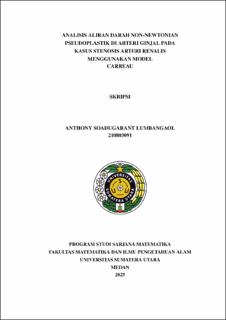Analisis Aliran Darah Non-Newtonian Pseudoplastik di Arteri Ginjal pada Kasus Stenosis Arteri Renalis Menggunakan Model Carreau
Analysis of Non-Newtonian Pseudoplastic Blood Flow In The Renal Artery Case of Renal Artery Stenosis With Carreau Model

Date
2025Author
Lumbangaol, Anthony Soadugarant
Advisor(s)
Tulus
Erwin
Metadata
Show full item recordAbstract
This study aims to analyze the behavior of blood flow as a non-Newtonian pseudoplastic
fluid in renal arteries that experience stenosis with a degree of narrowing of 60% in
various geometric shapes. The approach used in this study is a numerical simulation
method based on Computational Fluid Dynamics (CFD) using COMSOL Multiphysics
software, by combining the Navier-Stokes equation and the Carreau rheology model to
represent the properties of blood flow whose viscosity depends on the shear rate. The
geometry of the renal artery is built ideally by considering several stenosis scenarios:
partial circumferential narrowing, narrowing around the diameter, and double stenosis.
The simulation results show that stenosis with different shapes produces blood flow
velocity distributions that vary significantly, even though they have the same degree of
narrowing. Narrowing causes acceleration of blood flow in the stenosis area, increased
wall stress, and changes in flow patterns in the arterial branches that can affect the
distribution of perfusion to the kidneys. These findings show that in addition to the
severity of stenosis, the geometric shape of the stenosis also has a major effect on flow
dynamics and can be an important indicator in evaluating the clinical risk of kidney
disease. The application of this mathematical model provides a more comprehensive
understanding of hemodynamic phenomena and their relevance in a medical context.
Collections
- Undergraduate Theses [1486]
